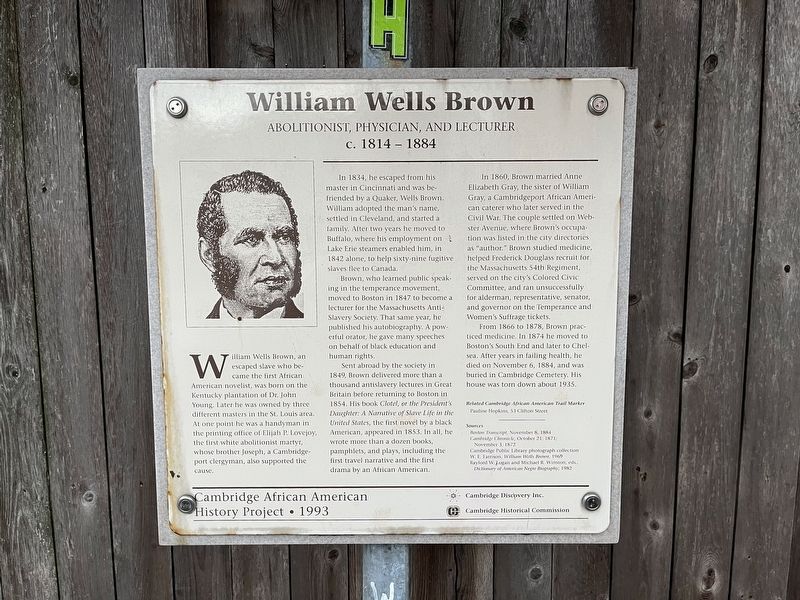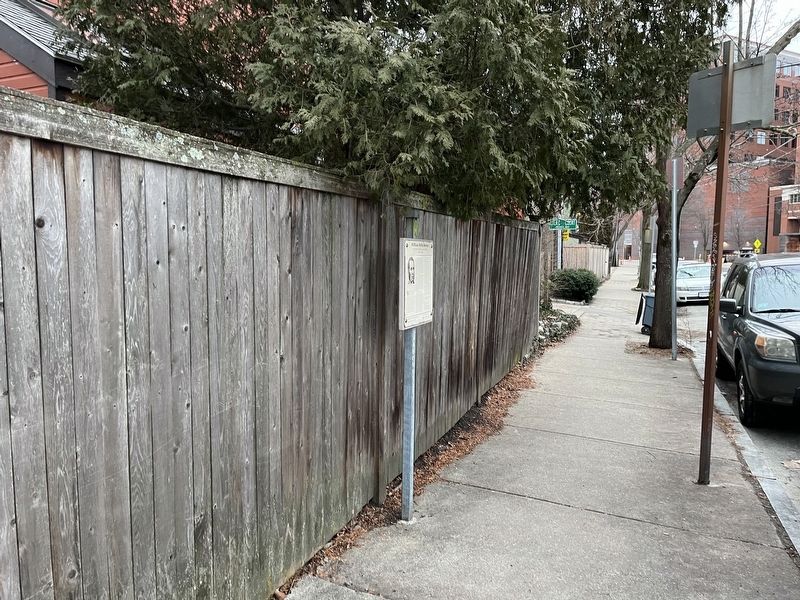Wellington-Harrington in Cambridge in Middlesex County, Massachusetts — The American Northeast (New England)
William Wells Brown
Abolitionist, Physician, and Lecturer
— c. 1814 - 1884 —
William Wells Brown, an escaped slave who became the first African American novelist, was born on the Kentucky plantation of Dr. John Young. Later he was owned by three different masters in the St. Louis area. At one point he was a handyman in the printing office of Elijah P. Lovejoy, the first white abolitionist martyr, whose brother Joseph, a Cambridge-port clergyman, also supported the cause.
In 1834, he escaped from his master in Cincinnati and was befriended by a Quaker, Wells Brown. William adopted the man's name, settled in Cleveland, and started a family. After two years he moved to Buffalo, where his employment on Lake Erie steamers enabled him, in 1842 alone, to help sixty-nine fugitive slaves to flee to Canada.
Brown, who learned public speaking in the temperance movement, moved to Boston in 1847 to become a lecturer for the Massachusetts Anti-Slavery Society. That same year, he published his autobiography. A powerful orator, he gave many speeches on behalf of black education and human rights.
Sent abroad by the society in 1849, Brown delivered more than a thousand antislavery lectures in Great Britain before returning to Boston in 1854. His book Clotel, or the President's Daughter: A Narrative of Slave Life in the United States, the first novel by a black American appeared in 1853. In all, he wrote more than a dozen books, pamphlets, and plays, including the first travel narrative and the first drama by an African American.
In 1860, Brown married Anne Elizabeth Gray, the sister of William Gray, a Cambridgeport African American caterer who later served in the Civil War. The couple settled on Webster Avenue, where Brown's occupation was listed as the city directories as "author." Brown studied medicine, helped Frederick Douglass recruit for the Massachusetts 54th Regiment, served on the city's Colored Civic Committee, and ran unsuccessfully for alderman, representative, senator, and governor on the Temperance and Women's Suffrage tickets.
From 1866 to 1878, Brown practiced medicine. In 1874 he moved to Boston's South End and later to Chelsea. AFter years in failing health, he died on November 6, 1884, and was buried in Cambridge Cemetery. His house was torn down about 1935.
Related Cambridge African American Trail Marker
Pauline Hopkins, 53 Clifton Street
Sources
Boston Transcript, November 8, 1884
Cambridge Chronicle, October 21, 1871; November 3, 1872
Cambridge Public Library photograph collection
W.E. Farrison, William Wells Brown, 1969
Rayford W. Logan and Michael R. Winston, eds., Dictionary of American Negro Biography,
Erected 1993 by Cambridge Discover Inc., Cambridge Historical Commission.
Topics. This historical marker is listed in these topic lists: Abolition & Underground RR • African Americans • Arts, Letters, Music • Government & Politics • Industry & Commerce • War, US Civil • Waterways & Vessels. A significant historical date for this entry is October 21, 1871.
Location. 42° 22.044′ N, 71° 5.549′ W. Marker is in Cambridge, Massachusetts, in Middlesex County. It is in Wellington-Harrington. Marker is on Webster Avenue just north of Lilac Court, on the right when traveling north. Touch for map. Marker is at or near this postal address: 1 Lilac Ct, Cambridge MA 02141, United States of America. Touch for directions.
Other nearby markers. At least 8 other markers are within walking distance of this marker. Lunsford Lane (within shouting distance of this marker); 'The Area 4 Story' (about 500 feet away, measured in a direct line); Alberta V. Scott (approx. 0.2 miles away); John J. Fatal (approx. 0.3 miles away); Danny Lewin (approx. 0.3 miles away); Davenport Car Manufactory (approx. 0.3 miles away); First Long-Distance Phone Call (approx. 0.3 miles away); The Massachusetts Avenue Baptist Church (approx. 0.4 miles away). Touch for a list and map of all markers in Cambridge.
Credits. This page was last revised on January 31, 2023. It was originally submitted on January 31, 2023, by Devry Becker Jones of Washington, District of Columbia. This page has been viewed 190 times since then and 44 times this year. Photos: 1, 2. submitted on January 31, 2023, by Devry Becker Jones of Washington, District of Columbia.

